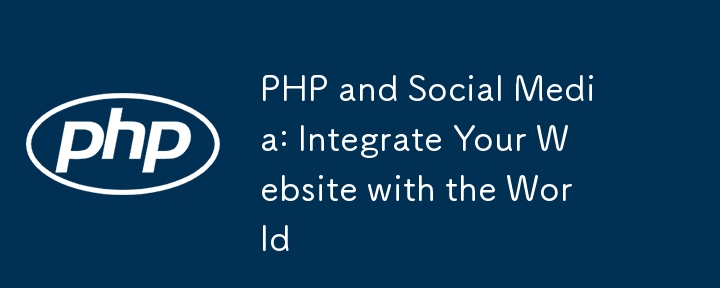
PHP provides tools to allow websites to easily integrate social media functions: 1. Dynamically generate social media sharing buttons for users to share content; 2. Integrate with the OAuth library to achieve seamless social media login; 3. Use the HTTP library to capture Get social media data and obtain user profiles, posts and other information.

PHP and Social Media: Make your website global
Introduction
Social media has become an integral part of the modern web, providing businesses and individuals with a valuable platform to interact with their audiences, promote products and build communities. PHP, a popular web development language, provides a range of tools to easily integrate social media functionality into your website.
Use PHP to integrate social media
1. Social media sharing button
You can use PHP to dynamically generate social media sharing Buttons that allow users to share content directly from your site.
$url = 'https://example.com/post'; $title = 'This is an example post'; echo '<a href="https://www.facebook.com/sharer/sharer.php?u=' . urlencode($url) . '" target="_blank">Share on Facebook</a>';
2. Social Media Login
PHP can be integrated with OAuth library for seamless social media login. This allows users to log into your website using their social media accounts, reducing the sign-up process and increasing convenience.
require_once 'vendor/autoload.php';
$provider = new \League\OAuth2\Client\Provider\Facebook([
'clientId' => 'YOUR_CLIENT_ID',
'clientSecret' => 'YOUR_CLIENT_SECRET',
'redirectUri' => 'YOUR_REDIRECT_URI'
]);3. Social media data capture
PHP can use cURL or other HTTP request libraries to capture social media data, such as user profiles, time Line posts and tweets.
$ch = curl_init('https://api.twitter.com/1.1/statuses/user_timeline.json?screen_name=php');
curl_setopt($ch, CURLOPT_RETURNTRANSFER, true);
curl_setopt($ch, CURLOPT_USERPWD, 'YOUR_CONSUMER_KEY:YOUR_CONSUMER_SECRET');
$tweets = json_decode(curl_exec($ch));Practical case
Blog website and Facebook integration
A Facebook integration on a PHP blog website The specific case is as follows:
Through these integrations, blogging sites effectively harness the power of social media to increase user engagement, increase sharing, and build an active community.
Conclusion
By leveraging the tools provided by PHP, you can easily integrate social media features into your website. From share buttons to social media logins and data scraping, use these technologies to improve user experience, increase website traffic, and reach a wider audience.
The above is the detailed content of PHP and Social Media: Integrate Your Website with the World. For more information, please follow other related articles on the PHP Chinese website!




